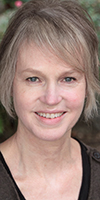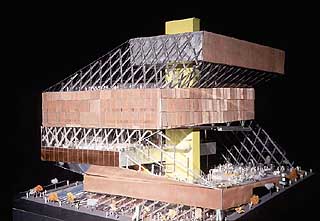|
Subscribe / Renew |
|
|
Contact Us |
|
| ► Subscribe to our Free Weekly Newsletter | |
| home | Welcome, sign in or click here to subscribe. | login |
Architecture & Engineering
| |

|
|
Design Perspectives By Clair Enlow |
July 19, 2000
Design Perspectives -- This program is an open book
The schematic design of the new downtown library is virtually complete, and the project is now entering the design development phase. To look closely at the project at this advanced stage is to experience startling recognition: It was all there months ago — in the graphics of the research, in the sketch, in the paper folded before our eyes by the hands of architect Rem Koolhaas at the formal presentation by the prospective designers.
Perhaps you were expecting another level of detail? Some reassuring, human-scale features like windows and doors? Relax. You are in the hands of a master modernist. You’ll see the humans themselves — when you are viewing the building at an angle to the rays of the sun. Otherwise, you’ll see the coppery glow of the building’s skin, a layered, structural covering of metal and glass.

|
The modernist dictum, “form follows function,” is not a stuffy law that guided the organization of this building, or a clue with which to read it. The function almost literally stands before us in the model. The rigorous, abstract geometry of the library design expresses the program, and little else. It is, to use one of Koolhaas’ favorite words, brutal. And beautiful? Yes. Form follows function.
The program for a large municipal library in the information age is a complex, fascinating puzzle, full of the practical, the futuristic and the human. In other words, getting the program right may be exactly enough to justify the form. Rem Koolhaas and his firm, OMA, have made a career challenge of understanding the changing programmatic elements of this project type. Now that there is a real design commission at a real point in time, the form for the Seattle library quite simply follows that all-consuming interest.
In the bound pages of the study that preceded the design concept for the building, the allocation of floor area for each separate function of the library appears in precise proportions like a many-colored, striped ribbon. After the stripes in this ribbon were arranged in vertical order based on interrelationships between activities and their relationships with the various street levels on the sloping site, the building was largely designed.
To create maximum spatial excitement with minimum departure from the diagram, the layers are simply pushed apart, leaving a stack of solid/orthogonal and transparent/non-orthogonal layers. The floor plates of the public areas are pulled out like drawers to meet the surrounding circumstances. Even at ground level, the walls are offset to expose views into the spaces below grade.
Layers representing the most intense storage, retrieval and administration functions form the solid blocks of the design. The transparent levels, with their sloping walls, will be occupied by visitors coming, going and circulating within the library. The activities behind the walls and interior features — if carefully orchestrated and truly visible — will complete the design.
One of the most compelling aspects of this deceptively simple solution is that the covering stretched over the pulled-apart and offset floor plates actually provides very efficient seismic stability in this earthquake-prone region. Since designing to today’s seismic codes means that most of the forces are lateral, the structural elements in the sharply sloping walls will absorb all of those forces as well as some of the weight. An unobtrusive grid of columns will complete the load bearing structure. Two of the world’s most prominent structural engineering firms, Ove Arup and Skilling Ward Magnusson Barkshire, are standing behind it.
In democratic fashion worthy of a public building, the most important “real estate” is nearest the ground. But since the grade changes dramatically on the one-block site, there is plenty of value to spread up and down between Fourth and Fifth avenues, which are connected by an escalator.
There are public entrances on both streets, with Fourth Avenue leading into the lobby and the auditorium, the children’s library and the language lab. The Fifth Avenue entrance leads into the “living room,” which may become the most expansive public indoor space in Seattle. Formal and informal lounge areas will be surrounded by a café, book checkout and fiction collections. The plan will exploit the visual connection with the under-appreciated federal courthouse lawn just across Fifth Avenue. A service entrance along Madison and a parking entrance on Spring will complete the busy circulation pattern in and out of the building.
The plan proudly extends the “cardiac assist” route up the hill that begins on First Avenue with the escalator in the Norton Building, winds through more escalators in the First Interstate Building and 1001 Fourth Avenue Plaza and ends at the library site. Climbers will have a choice of walking a hillside terrace along Spring Street or entering and taking the escalator within the library.
In the interior space plan, flexibility is the key — but flexibility in one area of the building is not the same as in another. It may mean accommodating shifting staff and services, changing technology, or evolving community amenities.
Research activities and the non-fiction collections has been an area of intense interest for the designers, according to OMA project architect Joshua Ramus.
The designers have done their own intensive research through hypothetical research projects. Today, for a single subject such as philosopher and scientist Rene Descartes, for instance, the investigating team might be shunted around to as many as eight different desks, each connected with a different collection, and often on different floors.
In the new Seattle library this would not happen. The “mixing” area on the fifth level of the library, below the four-story non-fiction collection, allows the visitor to meet with more than one librarian at once so that a strategy for accessing the needed material can be worked out. If the material can best be accessed through the Internet or other electronic means, the researcher can simply go down one level to the latest technological tools there.
Through consultation with high-tech industry leaders like Microsoft and with librarians who are known for their forward-thinking use of technology, the design team has learned that research is more and more likely to be conducted in group settings, using interactive technologies. So the floor designated for the most intensive applications of technology will also have plenty of room for meeting spaces. An alternate, more traditional scenario is for the individual researcher to settle in for a couple of days in the 18th century botany section.
Ironically, the sloping floors that have been such a consuming interest for Rem Koolhaas — showing up in his unbuilt design for the Jussieu University Library in Paris and in his folded paper at the Seattle interviews — will be largely hidden behind opaque walls in the Seattle library. But they will provide an ingenious element of flexibility where flexibility is most needed: in the floors holding the book stacks.
Flat floors necessarily imposed a logic on a collection, a logic that doesn’t necessarily exist, according to OMA’s Joshua Ramus, who has taken pains to explain the concept to the client and the public.
By ramping around in a four-cornered spiral, the stacks in the non-fiction section can increase or even contract without disrupting the Dewey Decimal System-based order of the collection. This disruption is a monumental problem in the design of libraries. Once collections grow beyond their space allotment, they must be broken up and isolated on separate floors.
As for books versus technology, the library and the designers are committed to the assumption that books are here to stay, and the library has plans to substantially increase its collections. Technology is the wild card. “No one knows the effect that technology is going to have,” said Robert Zimmer, design director for LMN Architects, OMA’s partner in the design of the library.
More than any other element, the new library is designed for people. But don’t look for a monument, or a trophy or a postcard view. Seattle’s new library is an honest expression of change, action and mutability — in other words, function.
Previous columns:
- Preservation: time is on our side, 05-17-2000


